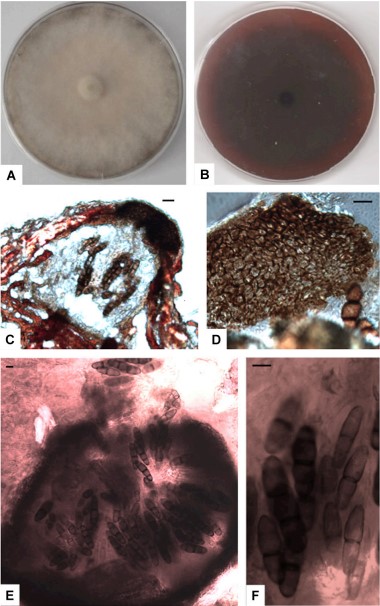Paralulworthia gigaspora sp. nov.
MycoBank number: MB 833288; Index Fungorum number: IF 833288; Facesoffungi number: FoF14532.
Type: Europe, Italy, Tuscany, Mediterranean Sea, Elba Island (LI), Ghiaie ISL, 3–5 m depth, 42◦49r04”N, 10◦19r20rrE March 2010, R. Mussat-Sartor and N. Nurra, on the sea grass P. oceanicarhizomes, MUT 435 holotype, living culture permanently preserved in metabolically inactively state by deep-freezing at MUT. MUT 672 and MUT 5413 = paratypes.
Etymology: in reference to the large size of the ascospores.
Description: growing actively on P. pinaster. Hyphae 3.2 µm wide, septate, from brownish to hyaline. Chlamydospores numerous, solitary and multicellular, from one to four-celled, 2 × 3 µm diam., from light to dark brown, globose and subglobose.
Colony description: growing on MEASW from 60 to 90 mm Ø after 28 days at 21◦C, mycelium from feltrose to floccose, from whitish to ochre, reverse from light brown to bordeaux. A caramel colored diffusible pigment and exudates were often present.
Asexual morph: not observed. Sexual morph: Ascomata 480-540 × 160–270 µm (x = 506.7 × 205 µm, n = 10), subglobose to ellipsoidal, single, scattered, immersed in the cortex or erumpent, brown to black at maturity; peridium dark brown 73-88 µm thick composed of several layers of thick-walled cells of textura angularis. Asci 115–130 × 30–40 µm (x = 118 × 31.8 µm, n = 10), fusiform to cylindrical, containing 8 spores, dehiscent, hyaline, vertically oriented to the host surface. Sterile elements not observed. Ascospores 76-83 × 19-25 µm (x = 79.3 × 21.7 µm, n = 10), uni- to 3-septate at maturity, constricted at septa (particularly the central one), ellipsoid to fusiform, pointed at both ends, thin-walled, from light to dark brown at maturity, straight.

FIGURE 6 | Paralulworthia gigaspora sp.nov. 28-days-old colony incubated at 21◦C on MEASW (A) and reverse (B); ascomata (C,E), peridium with textura angularis (D); asci with eight ascospores at different degrees of maturity (F). Scale bars 20 µm.
